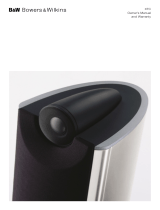
IMPORTANT SAFETY INSTRUCTIONS
1. READ these instructions.
2. KEEP these instructions.
3. HEED all warnings.
4. FOLLOW all instructions.
5. DO NOT use this apparatus near water.
6. CLEAN ONLY with dry cloth.
7. DO NOT block any ventilation openings. Install in accordance
with the manufacturer's instructions.
8. Do NOT install near any heat sources such as radiators, heat
registers, stoves, or other
apparatus (including amplifiers) that produce heat.
9. ONLY USE attachments/accessories specified by the
manufacturer.
10. USE only with a cart, stand, tripod, bracket, or table specified
by the manufacturer, or sold with the apparatus.
When a cart is used, use caution when moving
the cart/apparatus combination to avoid injury
from tip-over.
11. REFER all servicing to qualified service personnel. Servicing is
required when the apparatus has been damaged in any way,
such as power-supply cord or plug is damaged, liquid has
been spilled or objects have fallen into the apparatus, the
apparatus has been exposed to rain or moisture, does not
operate normally, or has been dropped.
This symbol indicates that there are important operat-
ing and maintenance instructions in the literature
accompanying this unit.
WARNING: To reduce the risk of fire or electrical shock, do not
expose this apparatus to rain or moisture.
WARNING: No user-serviceable parts inside. Refer all servicing to
qualified service personnel.
INSPECTION
We want your new speaker system to look as good as it did
leaving the factory! Please check promptly for any transit
damage. Carefully unpack your new speaker system and verify
the components against the packing list. In extreme circum-
stances, items may have become damaged in transit. If any
damage is discovered, notify the delivery service and dealer
where the system was purchased. Make a request for
inspection, and follow their instructions for evaluation.
Be sure to keep the product’s original shipping carton.
ABOUT YOUR KLIPSCH PURCHASE
Thank you for your purchase of Klipsch Heritage loudspeakers.
After reading this manual and connecting your system, you will
hear the result of over 60 years of stringent engineering and
class-leading research and development. Like all Klipsch
products, your loudspeakers feature Klipsch Horn-loaded
Technology—the guiding design for the first Klipschorn
®
developed in 1946 and for every Klipsch product that has
followed. Horn-loading allows your speakers to deliver very
high sensitivity, wide dynamic range, low distortion, controlled
dispersion and flat frequency response. This translates to
unequaled power, detail and dynamics, the hallmarks of
“The Klipsch Sound.” Please be sure to fill out the warranty card
at the back of this manual or online at www.klipsch.com so we
are better able to serve you. Again, thank you for choosing
Klipsch and we hope that your speakers bring life to your music
and movies for many years.
PAUL W. KLIPSCH
The Klipsch Heritage loudspeakers are the direct result of the
engineering design genius of Paul W. Klipsch. The technology
incorporated into these loudspeakers is as valid today as it
was in 1946 when Paul started Klipsch and Associates with
the launch of the Klipschorn
®
. The founder of our company
has been lauded as a pioneer and visionary in the audio
industry. Paul has had a remarkable career, the pinnacle of
which was his induction into the Engineering and Science Hall
of Fame in 1997. This honor puts him in such distinguished
company as Thomas Edison, George Washington Carver and
the Wright brothers, among others. Paul’s life was filled with
notable distinctions, including the 1994 dedication of the
Klipsch Department of Electrical and Computer Engineering at
New Mexico State University, Paul’s alma mater. In 1978, Paul
was awarded the prestigious Silver Medal by the Audio
Engineering Society of America as well as being inducted into
the Audio Hall of Fame. These are but a few of the achieve-
ments of a great audio engineer and an even greater man.
Hi-Fidelity magazine said about Paul that he was, “the image
of one who pushes toward the frontier and reestablished it
wherever he arrives.” The November 1986 issue of Audio
magazine sums up Paul W. Klipsch and his influence on the
industry, ”. . . the Klipschorn along with its designer Paul
Klipsch, are true legends in the field of high-fidelity sound.
Nothing I could write would do complete justice to its
description.”
KLIPSCHORN
Paul Klipsch’s design goal was to reproduce the dynamics and
excitement of a live symphony orchestra performance in
his living room. An engineering breakthrough when it was
introduced, the Klipschorn
®
remains one of the most highly
praised loudspeakers in the world and is the only loudspeaker
that has been in continuous production for over 60 years. The
Klipschorn is a testament to design that stands the test of
time. With extremely high sensitivity, this three-way, fully horn-
loaded loudspeaker features a folded tri-hedral bass horn that
utilizes the walls and corners of the listening room as part of
its design. This combination of attributes enables it to span
more than nine full octaves with dynamic, smooth, ultra low
distortion sound.
LA SCALA II
The La Scala was developed as a more portable Klipschorn to
serve as a public address speaker for the 1963 gubernatorial
campaign of Winthrop Rockefeller. Like the Klipschorn, it
displays extremely high sensitivity and is a fully horn-loaded,
three-way speaker featuring a shorter, two-fold bass horn that
can operate independently of listening room corners. As a
result, the La Scala’s only sonic compromise as compared to
the Klipschorn is a slightly higher bass cutoff.
CORNWALL III
The Cornwall was introduced in 1959 as a larger full range
alternative to the Heresy as a center channel speaker in a
English











